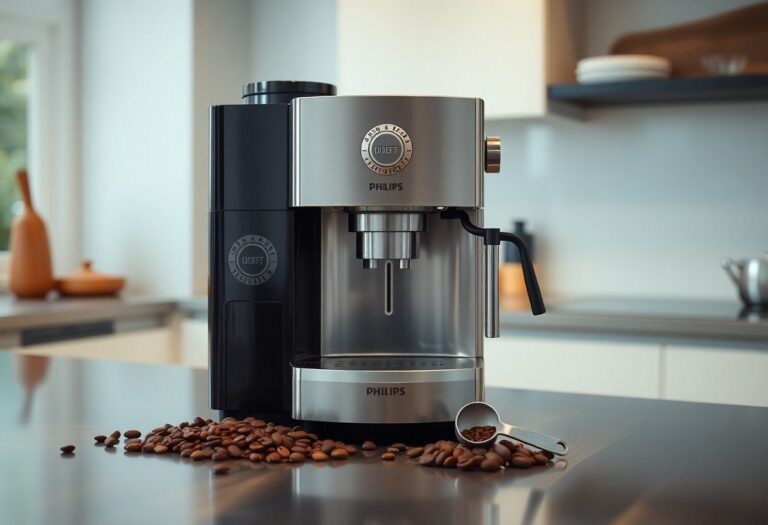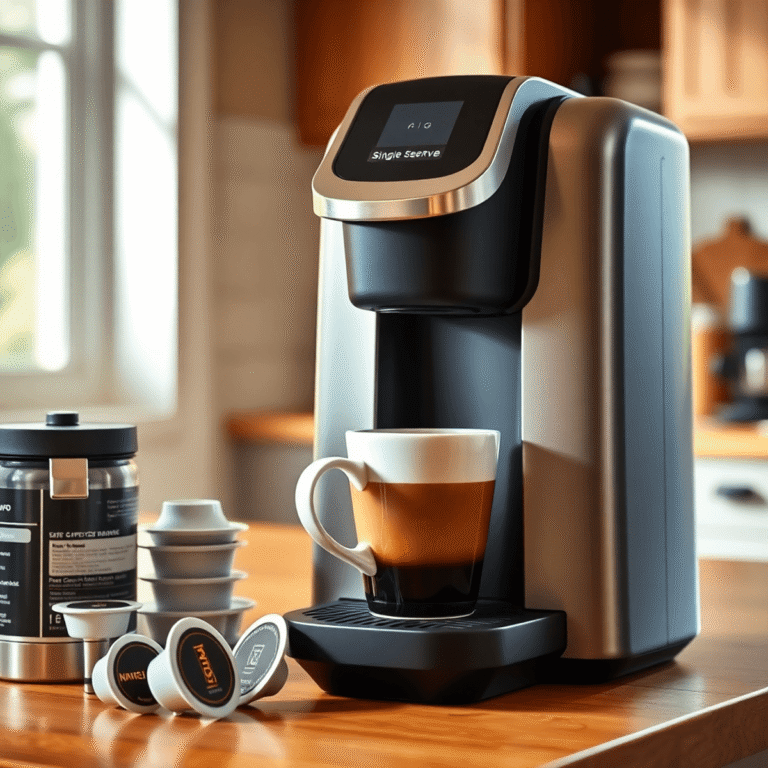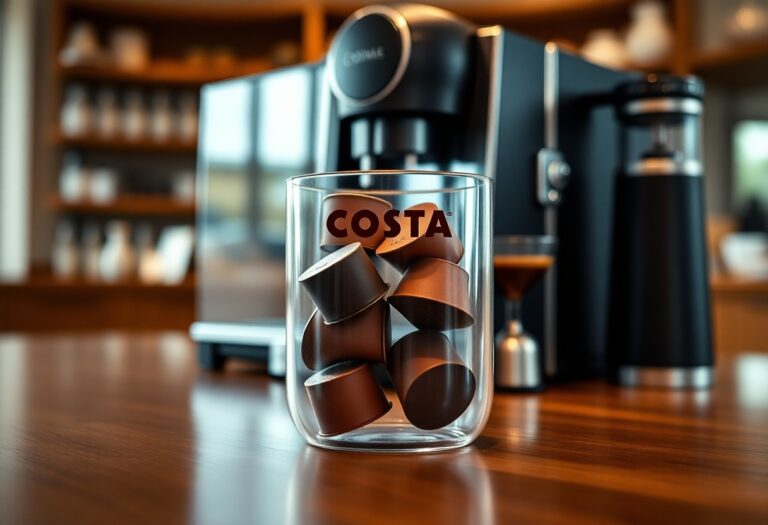What Coffee Do I Use in an Espresso Machine – Personal Selection
Many coffee enthusiasts often find themselves pondering what coffee to use in their espresso machines. The choice of coffee beans significantly impacts the flavor and quality of your espresso, making it crucial to select the right type for the best results. You’ll want to explore various roast levels and blends to discover your personal preferences. For in-depth insights, check out this What Coffee to Use for Espresso Machine? (Complete Guide), which can guide you through your selection process.

Key Takeaways:
- The type of coffee bean plays a significant role in the flavor profile of your espresso; select beans that are specifically labeled for espresso use.
- Freshly roasted beans are vital for achieving the best taste; aim to use beans that have been roasted within the last 2-4 weeks.
- Grind size is important; use a fine grind for espresso machines to ensure optimal extraction of flavors during brewing.
- Experiment with different coffee origins and blends to find your preferred taste; personal flavor preferences can vary widely.
- Consider using a scale to measure the coffee dose and brew time for consistency in your espresso shots.
Crafting the Perfect Espresso Blend
Creating an ideal espresso blend involves selecting the right combination of beans to achieve a harmonious flavor profile. A well-balanced blend should integrate various coffee bean origins, roast levels, and flavor notes. By experimenting with different pairings and proportions, you can tailor your espresso to complement your taste preferences—whether that’s a bright, fruity note or a rich, chocolatey depth. The journey to crafting your perfect espresso is both an art and a science, resulting in a uniquely satisfying brew for your espresso machine.
Key Characteristics of Espresso Beans
Espresso beans typically exhibit a full-bodied flavor, with bold acidity and a rich crema. Ideal beans often blend Arabica and Robusta varieties; Arabica provides sweetness and complexity, while Robusta adds body and crema stability. Look for beans with nutty, chocolatey, or fruity tasting notes that will shine when brewed under pressure, enhancing the overall espresso experience.
The Role of Roast Levels in Flavor Profile
Roast level significantly impacts your espresso’s flavor profile. Lighter roasts tend to highlight acidic and fruity notes, while medium roasts offer a balanced sweetness, and dark roasts deliver a more intense, bitter flavor. Each roast level produces a different aroma and mouthfeel, directly affecting the final cup.
When dicking out the roast level for your espresso, consider how the intensity impacts the overall flavor experience. For instance, a light roast can bring out floral and citrusy aromas but may lack the robust body desired in a classic espresso. Conversely, a dark roast, with its caramelized sugars and deep chocolate notes, provides a bold flavor that dominates the palate. Experimenting with various roast levels allows you to discover the right balance that resonates with your taste preferences, enhancing your espresso experience while brewing at home.
Single Origin vs. Blends: Making the Choice
Choosing between single origin coffees and blends can significantly shape your espresso experience. Single origin refers to coffee sourced from one location, showcasing unique flavor profiles that reflect the region’s climate and soil. In contrast, blends combine beans from multiple origins to create a balanced flavor, aiming to deliver a consistent taste regardless of seasonal variations. Both options offer distinct advantages, thus understanding the implications of your choice can elevate your daily brew.
What Single Origin Offers to the Espresso Experience
Single origin coffees invite you to explore the distinct flavors that come from specific regions, like the bright acidity of an Ethiopian Yirgacheffe or the rich chocolate notes of a Colombian coffee. This variety can enhance your palate, providing a unique narrative and allowing you to appreciate the craftsmanship behind each cup. Emphasizing purity and authenticity, single origin often appeals to those seeking an unadulterated coffee experience.
Benefits and Drawbacks of Espresso Blends
Espresso blends offer both advantages and challenges. They often balance flavors, giving you a consistent cup regardless of the season. With the ability to combine the best qualities of various beans, blends can produce a rich complexity that suits a wide range of preferences. However, the flavor might lack the distinctive glory found in single origins and can sometimes be more generic, as the artistry of specific regional notes gets diluted. Additionally, finding quality blends that truly showcase individual beans can sometimes be challenging.
While espresso blends can promise a harmonious taste that appeals to a broad audience, this consistency can sometimes leave flavor nuances overshadowed. High-quality blends often require meticulous sourcing, with roasters carefully selecting beans to achieve balance while maintaining interest. For instance, the renowned Lavazza Super Crema combines Brazilian and Indonesian varieties to create a delightful profile that remains popular, though it doesn’t push the boundaries like a well-crafted single origin might. Ultimately, the choice between blends and single origins hinges on whether you value complexity over consistency in your espresso journey.

The Importance of Freshness
Freshness is a game-changer in espresso. The flavor and aroma of coffee beans peak just after roasting, making it crucial to brew with beans that haven’t aged. As beans oxidize and lose crucial oils, your espresso may taste flat or dull, lacking the rich complexity you desire. In pursuit of the best cup, embrace freshness as a vital component in your coffee selection.
How Bean Age Affects Flavor and Extraction
Beans lose their vibrancy and distinct flavors over time, impacting both taste and extraction. Ideally, espresso should be brewed with beans roasted no more than two weeks ago. After this duration, volatile compounds diminish, resulting in weaker aromas and flavors. This decline in freshness can lead to undesirable bitterness or sour notes, undermining your espresso experience.
Tips for Sourcing and Storing Fresh Beans
To enjoy optimal espresso flavor, source your beans from reputable roasters who indicate roasting dates. Storing beans properly involves keeping them in a cool, dark place, preferably in an air-tight container. Avoid exposure to light and air, which accelerate staleness. Any efforts you make to procure fresh beans will enhance your coffee enjoyment significantly.
- Seek out local roasters who prioritize freshness.
- Consider purchasing whole beans and grinding just before brewing.
- Choose storage solutions that limit air exposure and maintain optimal climate conditions.
- Your beans should be kept away from moisture and temperature fluctuations.
Explore the many sources of fresh beans by visiting local farmers’ markets, specialty coffee shops, or trusted online retailers known for quick shipping. You can even sign up for subscription services that deliver fresh roasts directly to your door. Whichever route you choose, prioritize your preferences to curate a thriving espresso experience. Any choices you make will reflect in the quality of your coffee.
- Look for roasting dates clearly marked on packaging.
- Seal your beans tightly within an opaque container.
- Limit exposure to oxygen by using one-way valves for minor releases of gases.
- Remain vigilant about purchase frequency to ensure you always have fresh beans at hand.
Grinding for Success: How Grind Size Impacts Espresso
The grind size of your coffee beans significantly influences the flavor and quality of your espresso. A proper grind allows for optimal extraction, leading to a well-balanced shot that highlights the nuanced flavors of your chosen beans. Too coarse, and water will flow too quickly through, yielding a sour taste; too fine, and it could lead to bitter, over-extracted notes. Understanding how grind size affects your brew is key to achieving the perfect cup of espresso.
Ideal Grind Size for Optimal Extraction
Your ideal grind size for espresso should resemble granulated sugar—fine but not powdery. This consistency ensures that water passes through the coffee evenly and at the correct rate. Aim for a feel that allows you to form a small ball with the grounds; this indicates they’re packed enough for proper extraction. Adjusting this grind size can make all the difference in flavors extracted from your beans.
Common Grinding Mistakes and Their Solutions
Many espresso enthusiasts fall into the trap of using the wrong grind size or inconsistent grind, which can adversely affect the extraction process. If you’re getting shots that are either too bitter or too sour, it often stems from improper grinding. Adjust your grinder to produce a consistent particle size and regularly check for clogs or unevenness that can change extraction rates, impacting the overall flavor of your shot.
For instance, using a blade grinder might result in uneven particle sizes that lead to both under-extraction and over-extraction during brewing. Opting for a burr grinder, which provides a consistent grind, helps mitigate this issue. Additionally, when switching between different types of beans, recalibrating your grind size is necessary, as every coffee variety has its distinct characteristics and extraction requirements. Regularly experimenting and adjusting your grind can elevate your espresso experience to new heights.
Experimentation: Finding Your Personal Preference
Experimenting with different coffee varieties is a key journey in discovering your personal espresso preference. Allow your taste buds to explore a wide range of flavors and aromas, and take notes on what resonates with you. Combining distinct roast levels, processing methods, and bean origins will aid in your quest to pinpoint which combinations deliver the ultimate espresso experience for your palate. Dive deeper into this exploration by checking out What Type of Ground Coffee for Espresso Machine.
The Benefits of Tasting Different Coffees
Sampling a variety of coffees not only broadens your palate but also enhances your understanding of unique flavor profiles. By tasting both single-origin and blended options, you’ll gain insights into how different beans interact within the espresso-making process. Each coffee possesses distinct characteristics that can surprise and delight you, ultimately refining your preferences as you explore new tastes and aromas.
Customizing Brew Parameters to Enhance Your Espresso
Altering parameters such as brew time, temperature, and pressure can dramatically shift your espresso’s flavor profile. Tailoring these factors to match your chosen coffee will yield a more personalized and satisfying cup. Whether it’s experimenting with a shorter extraction to highlight brighter notes or adjusting the temperature to mellow the brew, the interplay of these elements will help you unlock the full potential of each coffee you try.
Adjusting the brew parameters goes beyond simple trial and error; it allows you to explore how these factors influence the extraction process, ultimately impacting acidity, sweetness, and body in your espresso. For instance, a higher brewing temperature may accentuate the brightness of a light roast, while a longer extraction time could enhance the richness in a dark roast. Take note of each adjustment and how it transforms your drink, creating a tailor-made espresso experience that aligns perfectly with your taste preferences.
Final Words
As a reminder, selecting the right coffee for your espresso machine is key to achieving that perfect cup. Focus on using high-quality, freshly roasted beans that align with your personal taste preferences. Experimenting with different blends and roast levels can help you discover your ideal flavor profile. Don’t hesitate to grind your coffee just before brewing, as freshness plays a significant role in the quality of your espresso. Ultimately, your personal selection will make all the difference in enjoying the rich, bold experience that espresso offers.
FAQ
Q: What type of coffee beans should I use for my espresso machine?
A: For espresso, it is best to use high-quality coffee beans that are specifically roasted for espresso. Look for beans that have a medium to dark roast profile, as these develop the rich, bold flavors that espresso is known for. Arabica beans are commonly preferred for their sweetness and complexity, while a blend that includes Robusta can add body and crema to your shot.
Q: How finely should I grind my coffee for espresso?
A: The grind size for espresso should be fine, similar to the texture of table salt or powdered sugar. This fine grind allows for optimal extraction during the brewing process, ensuring that you get the best flavor from the coffee. If the grind is too coarse, the espresso may taste weak; if it’s too fine, it may lead to over-extraction and bitterness.
Q: Can I use pre-ground coffee in my espresso machine?
A: Although it’s possible to use pre-ground coffee, it’s not recommended if you want the best flavor from your espresso. Pre-ground coffee tends to lose freshness quickly and may not have the ideal grind size for espresso. If you’re using pre-ground coffee, make sure it’s specifically labeled for espresso to increase your chances of getting a satisfactory result.
Q: How much coffee should I use for a single shot of espresso?
A: A standard single shot of espresso typically requires about 7 to 9 grams of coffee. For a double shot, you should aim for around 14 to 18 grams. It’s important to weigh your coffee for consistent results, as this impacts the flavor and quality of the espresso. Adjusting the dose can significantly change the outcome of your shots.
Q: Are there specific coffee brands that work best for espresso machines?
A: While the best coffee brand is largely based on personal preference, some well-known brands that offer exceptional espresso blends include Lavazza, Illy, and Peet’s Coffee. It’s worth experimenting with different local roasters and specialty brands to discover unique flavors that suit your palate. Look for blends labeled as espresso to ensure they are formulated to work well in your machine.







